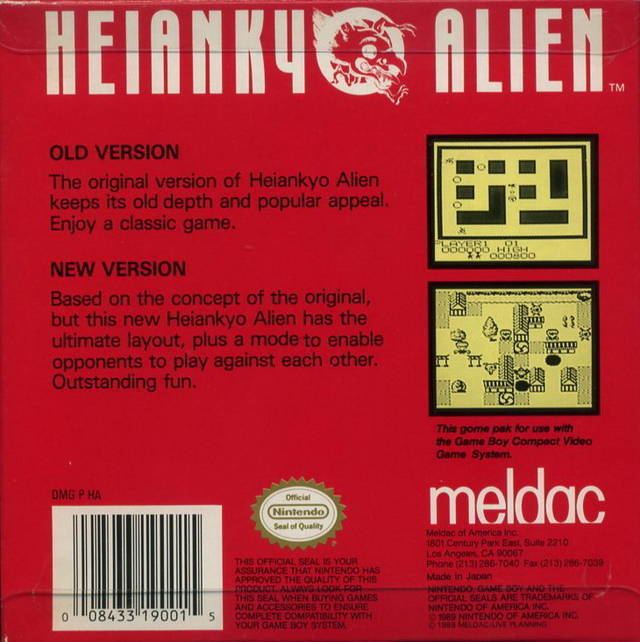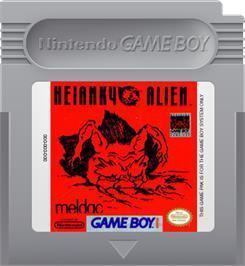10 /10 1 Votes10
Initial release date 1979 Display Raster graphics | 5/5 Emuparadise Mode(s) Up to 2 players | |||||||||||||||||||||||||||||||||
Designer(s) TSG (University of Tokyo) Sound Amplified Mono (one channel) Similar Nihon Bussan games, Puzzle video games | ||||||||||||||||||||||||||||||||||
Game boy world 029 heiankyo alien hyperware meldac 1990
Heiankyo Alien (平安京エイリアン, Heian-kyō Eirian) is a video game created by the University of Tokyo's Theoretical Science Group (TSG) in 1979. The game was originally developed and released as a personal computer game in 1979, and was then published by Denki Onkyō Corporation (電気音響株式会社, Denki Onkyō Kabushiki Gaisha) as an arcade game in May 1980. The game has been ported to several other gaming systems since its original release.
Contents
- Game boy world 029 heiankyo alien hyperware meldac 1990
- Game boy longplay 059 heiankyo alien
- Gameplay
- Arcade versions
- Ports
- Influenced games
- References
Game boy longplay 059 heiankyo alien
Gameplay
The player controls a Heian period police officer (kebiishi (検非違使)) who must defend the capital city (Heian-kyō (平安京)) from an alien invasion by digging holes in the ground and filling them back up after an alien falls inside. The player scores points for every alien trapped, and the quicker the hole is filled up after the alien falls in, the higher the number of points are scored. The aliens increase in number as the levels progress, and they can escape from holes after a certain period of time elapses or if another alien passes above their hole. The player loses if he comes in contact with an alien. There is a time limit for each level, and the number of aliens increases drastically when this limit is reached, essentially preventing the player from completing the level.

The player can enter his name on the arcade machine if a high score is reached. In the original version of the game, a unique cursor is employed where the player selects a letter by having his character walk through the street that displays the desired letter. The game also contains a two-player mode, where the players can either alternate turns or play on the same screen simultaneously.
The arcade version uses a Zilog Z80 microprocessor, and the arcade system board used is a copied version of the one used by Sega's Head On. Since the original system board itself was a copy, Heian-kyō Alien's system board was easily duplicated, and many of the units distributed to arcade centers were "copies of a copy" created by other companies. Few of the original units manufactured by Denki Onkyō remain in place today.
Arcade versions

Many copied arcade versions of the game exist with differences in background color and sound effects. Taito Corporation produced a version with a light-blue background that recycled many sound effects from Head On. The unit's cabinet and instruction card were created specifically for the version by Taito, but it is not known whether the version was a licensed manufacture or a copy. Hōei Sangyō (now Banpresto) produced an arranged version called Time Alien where alien movements are much quicker (however, the game lags whenever the player tries to dig or fill up a hole). In 1980, a North American version titled Digger (unrelated to the Canadian computer game Digger) was created by Sega and Gremlin Industries, with minor changes in appearance.
Ports
Meldac released a Game Boy version of the game in Japan and North America in 1990. This port includes a remake version where a new type of alien appears to chase after the player's character. The game was also ported to the Super Famicom by Nihon Bussan in 1995 as Nichibutsu Arcade Classics 2: Heiankyo Alien. The company had previously released a licensed remake titled Kid no Hore Hore Daisakusen. The game was also made available for the Microsoft Windows operating system in 1999 by Hyperware, and various mobile phone versions are available on i-mode, Vodafone live!, and EZweb.
Influenced games
Space Panic (1980) and its clones (e.g. Apple Panic) also feature trappable aliens while Lode Runner's (1983) enemies are human guards. Doraemon Meikyū Daisakusen (1989) and Boomer's Adventure in ASMIK World (1989) are later examples. The Commodore VIC-20 cartridge game Alien appears to be a direct clone of Heiankyo Alien.
